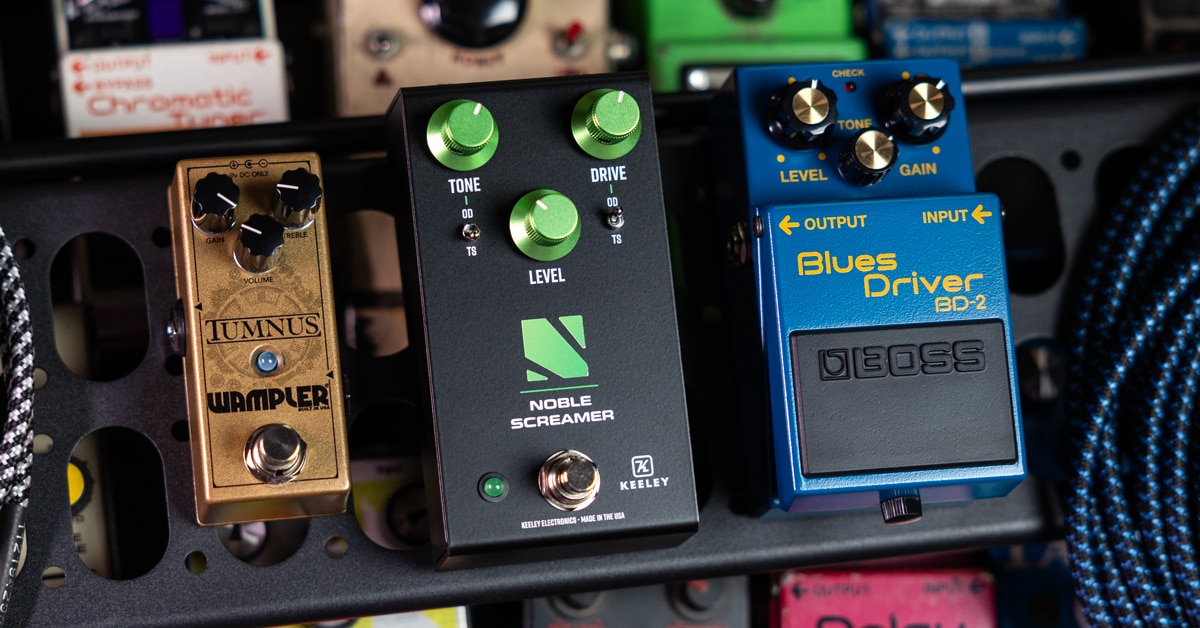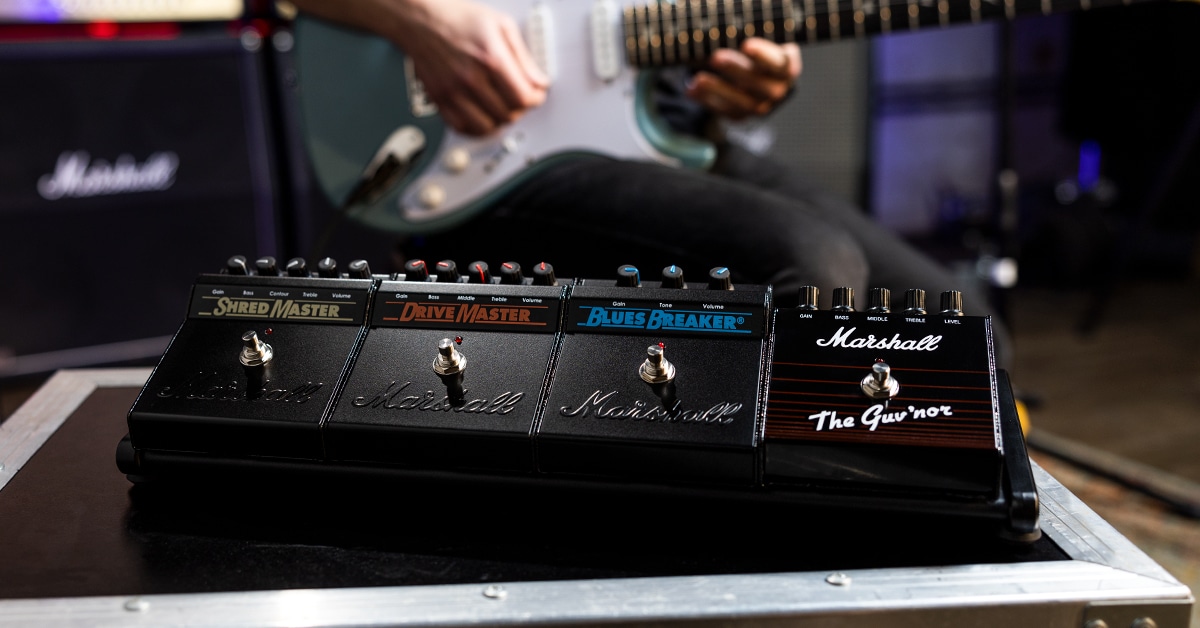The message was loud and clear: “Put yourself in charge—get yourself a Guv’nor.”
Marshall’s 1989 magazine ad announced the legendary amp company’s Guv’nor overdrive, and as bold as the promotional language was, it somehow understated the pedal’s true majesty. Not just another drive pedal, the Guv’nor was actually the first “amp-in-a-box,” designed to emulate the sound of a Marshall stack at a feral roar. Soon thereafter, amp simulators became an essential pedal category, with various models produced by boutique circuit builders and major gear manufacturers alike.
Between 1991 and 1992, Marshall expanded its pedal line by releasing a trio of “black box” drives—the Bluesbreaker (a simulation of the 1962 Bluesbreaker amp famously used by Eric Clapton), Drivemaster (essentially a reengineered Guv’nor) and Shredmaster (a high-gain distortion). They were not immediate hits, and Marshall discontinued the line in the late 1990s.
Then, something happened. Radiohead guitarist Jonny Greenwood used a Shredmaster on the band’s masterpiece, OK Computer, in 1997—also giving it pride of place on his pedalboard—and the Marshall pedal madness ramped up. In 2006, another guitar hero came along to advance the cause when John Mayer plugged into a Bluesbreaker pedal for his multi-platinum Continuum album. As a result, the used market for the black box series enjoyed a thunderous boost, as players re-evaluated the sonic gravitas of the pedals.
After two decades of players seeking vintage black box pedals on the used marketplace—not to mention all of the boutique builders doffing their caps to these influential circuits—Marshall surprised everyone this year with a meticulous reissue of its four early drive pedals. In an exclusive Riffs interview, Marshall Product Specialist Steve Smith talks about the 2023 release of the Guv’nor, Drivemaster, Bluesbreaker and Shredmaster.
How did this Marshall reissue project come together?
Steve Smith: We were very aware of how popular these pedals have become on the used market. Plus, the pedals have been copied by numerous manufacturers, so we thought we’d offer players the real deal. Of course, the original designer has long since retired, but we did have the original drawings and schematics to work from. Our aim was to recreate these pedals to the original specifications, and without any compromises. To that end, we tested the reissues against original units from the late ’80s and early ’90s.
The Guv’nor came out in 1988, and it was the first significant pedal release for Marshall since the Supa Fuzz in the late ’60s. What inspired the company to develop the Guv’nor?
The original thinking was to give players the sound of a roaring Marshall stack in a pedal. Although this is quite common now, in 1988, amp-in-a-box pedals didn’t really exist. We were first to the game.
In the early ’90s, the Guv’nor was rebranded as the Drivemaster, and it was released along with the Shredmaster and the Bluesbreaker. Can you tell us a bit about the tone targets of those pedals?
The Bluesbreaker was designed to be a lighter, softer-clipping overdrive that would be ideal for on-the-edge-of-breakup tones, as well as classic rock. Getting a little higher with the gain factor, the Drivemaster was designed for classic rock on up to hard rock tones. Finally, the Shredmaster was really for metal players, as it offers more gain and compression than the other two. However, the Shredmaster is also a great pedal for rock and blues tones.
The Bluesbreaker obviously draws its sonic inspiration from the original 1962 Bluesbreaker amp. Was there a tonal starting point for the other pedals?
The pedals aren’t designed to copy the sound of a particular amp. It was more about capturing how some of our amps were being used stylistically. The Guv’nor and Drivemaster could be associated with ’80s rock and the Marshall JCM800 series, which was our flagship amp at the time. The Shredmaster was more of a modded variant—a bit like a Marshall being pushed with a boost/EQ.
Just a few years after its initial release, the Bluesbreaker caught fire. What do you think was so special about that pedal, and how did it become so popular?
The Bluesbreaker is a great pedal for enhancing the tone and feel of your favorite amp. It also fit in well with a particular genre of music at the time that was fronted by John Mayer—and he obviously helped drive the pedal’s popularity.
From the ’00s onward, the Bluesbreaker pedal clearly inspired a lot of boutique builders to craft their own versions and variations. Did any of those pedals impact your approach to the Marshall reissues?
We thought about making tweaks and changes to bring them up to date. But the original pedals are now considered vintage, and they’re popular for a reason. With this in mind, we thought we’d leave them alone and do a faithful reissue.
Were there any unique challenges that popped up as you worked on the reissues?
The only real challenge was dealing with pedals that are more than 30 years old. Our original reference units have aged, and, of course, have component tolerances to deal with—which means they may not sound exactly as they did when first released. However, we’re confident the sound of the reissues is spot on.
What do you foresee as the future of Marshall pedals?
Jim Marshall’s approach was “let the market decide.” So, as long as people are buying them, we’ll make them. This project may also create interest in making some more pedals based on other Marshall amps or designs.










